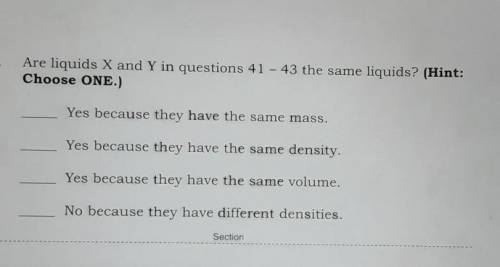
Chemistry, 18.10.2020 16:01 nicoleskertich
3. Are liquids X and Y in questions 41 - 43 the same liquids? (Hint: Choose ONE.) Yes because they have the same mass. Yes because they have the same density. Yes because they have the same volume. No because they have different densities.


Answers: 3


Other questions on the subject: Chemistry

Chemistry, 21.06.2019 14:40, wbrandi118
Water ionizes by the equation h2o(l)⇌h+(aq)+oh−(aq) the extent of the reaction is small in pure water and dilute aqueous solutions. this reaction creates the following relationship between [h+] and [oh−]: kw=[h+][oh−] keep in mind that, like all equilibrium constants, the value of kw changes with temperature.
Answers: 1


Chemistry, 22.06.2019 05:30, mandy9386
You are making a solution of calcium chloride dissolved in water. you add solid, stir, and it dissolves. you add just a spatula tip full, stir, and the solid does not dissolve. how could you describe the solutions before and after adding the spatula tip amount
Answers: 1

Chemistry, 22.06.2019 09:00, dante766
Achemist 16 drop copper metal from copper chloride solution. the chemist place is 0.50 g of aluminum foil in a solution containing 0.75 g of copper (ii) chloride. a single replacement reaction takes place. which statement explains the maximum amount of copper that the chemist can extract using this reaction?
Answers: 1
You know the right answer?
3. Are liquids X and Y in questions 41 - 43 the same liquids? (Hint: Choose ONE.) Yes because they h...
Questions in other subjects:


Social Studies, 17.07.2019 09:00





Arts, 17.07.2019 09:00





